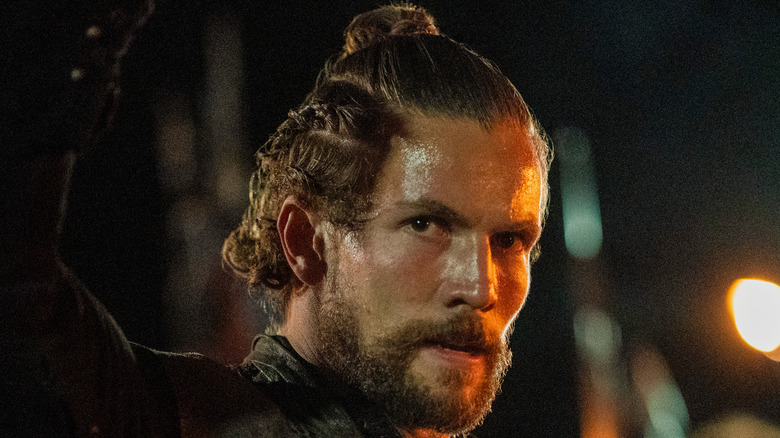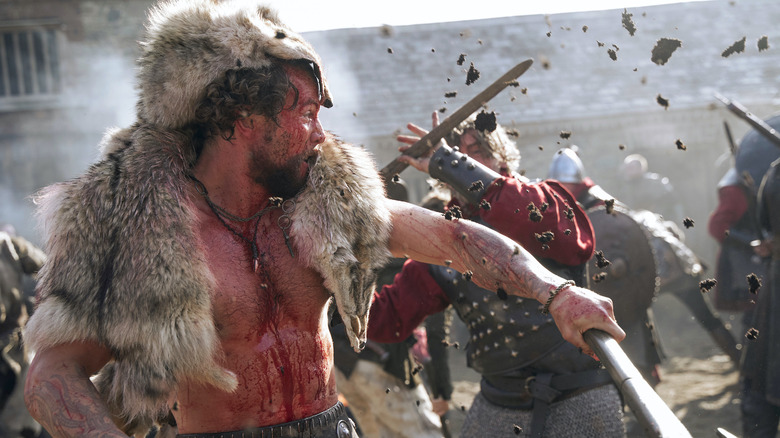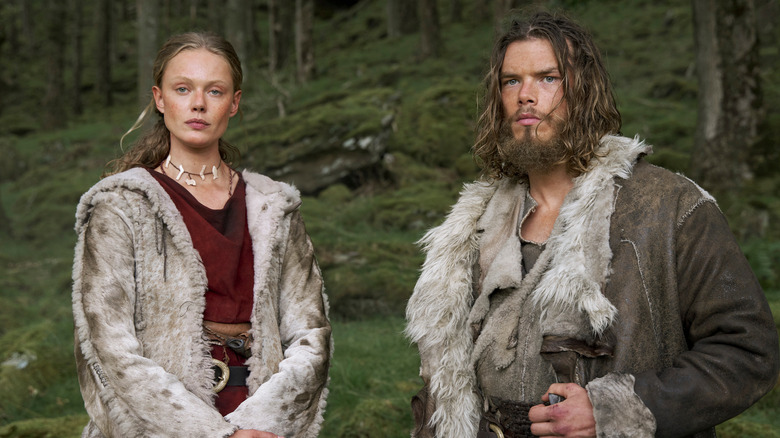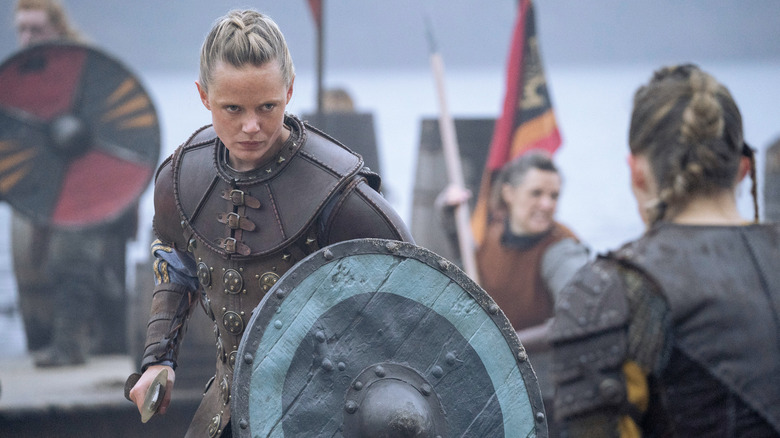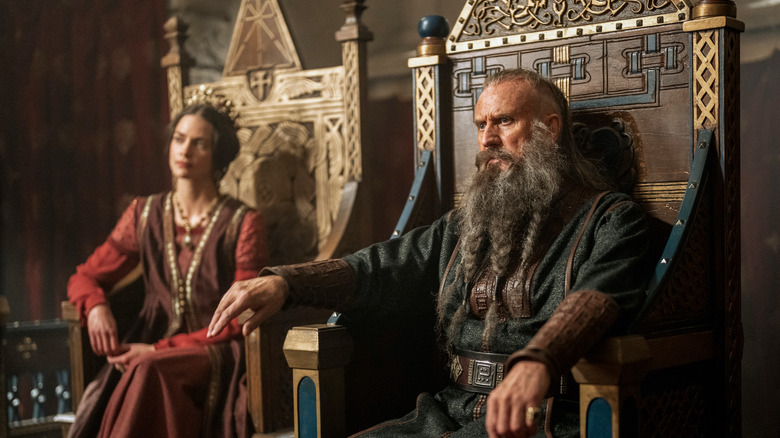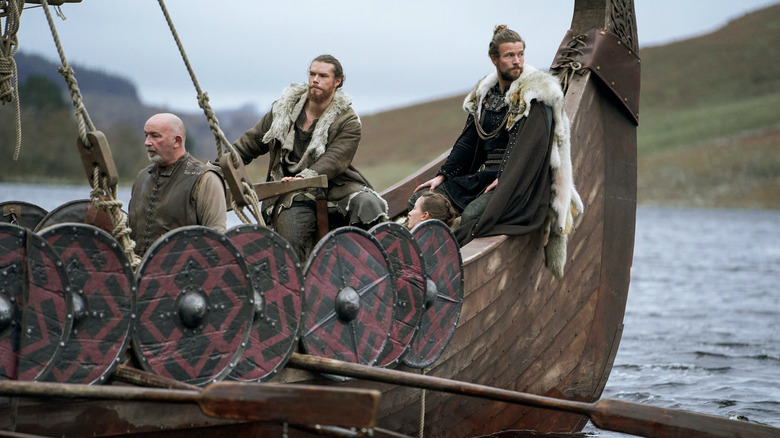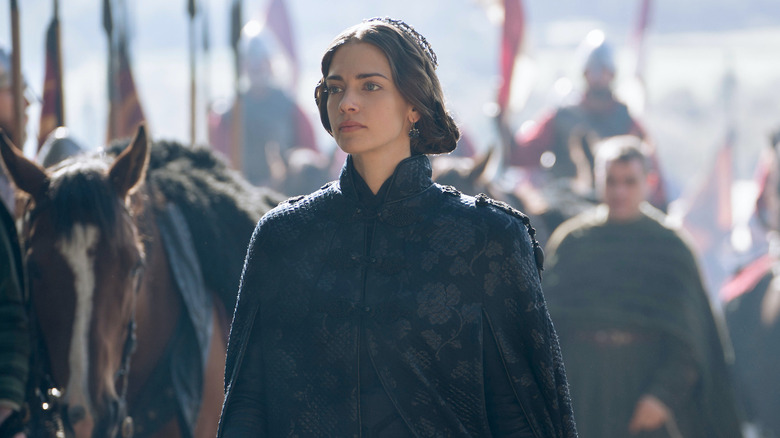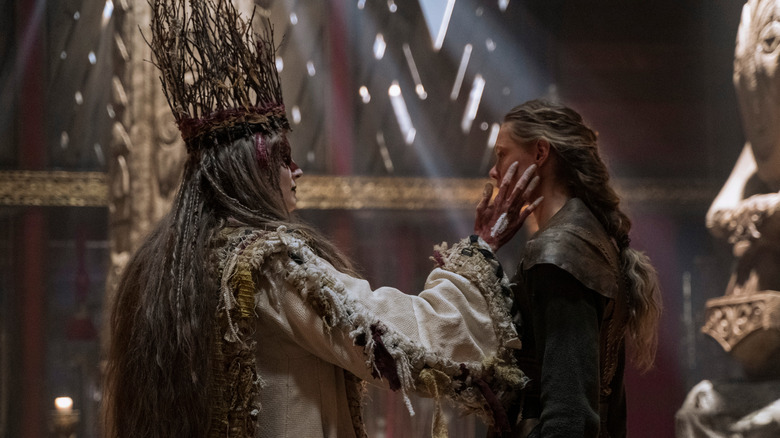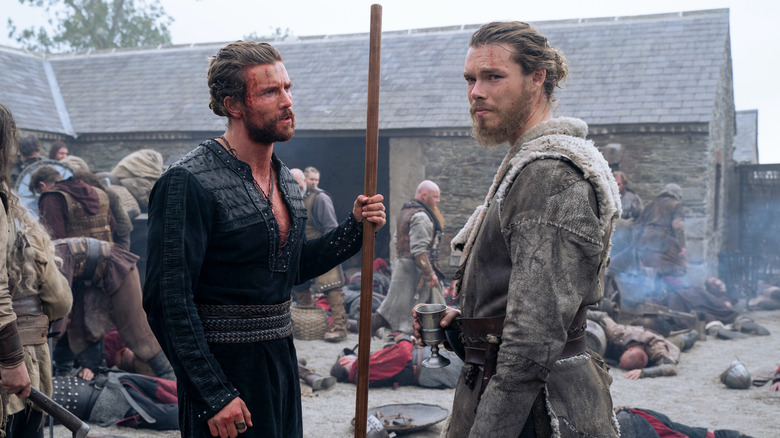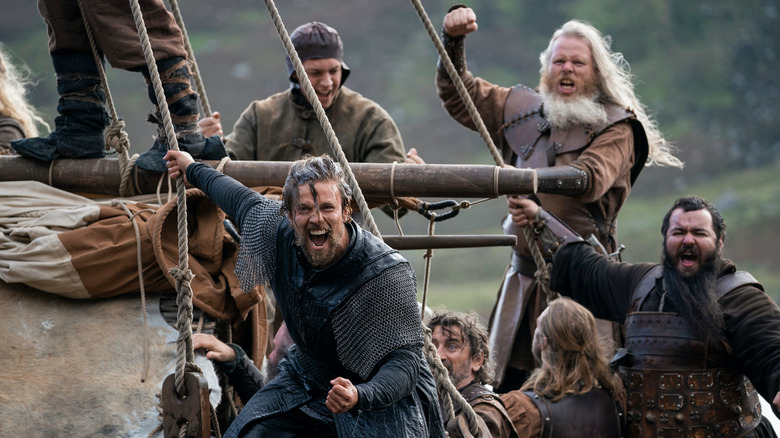The Best And Worst Things About Vikings: Valhalla
"Vikings: Valhalla" bursts with action and adventure while telling an engrossing tale of world-changing struggles for power and control in the eleventh century. A spinoff of the popular historical drama "Vikings," Netflix's "Valhalla" nods to the previous series but isn't bound by it. That's because while "Vikings" chronicled the beginning of the Viking Age through the activities of the legendary Ragnor Lothbrok (Travis Fimmel), "Valhalla" is set over 100 years in the future at the start of the Viking Age's end.
The new show centers on several well-known historical figures, including explorer Leif Eriksson (Sam Corlett), his determined sister Freydis Eriksdotter (Frida Gustavsson), and the future King of Norway Harald Sigurdsson (Leo Suter), at a time when a rift is growing between Vikings who adhere to the old pagan beliefs and those that have accepted the new Christian religion. Yet even as their divisions cause them to take aim at one another, the Vikings come together as one when the English lash out against them from abroad.
This makes for a show that's ripe for drama, and it more that delivers with intriguing characters, surprising alliances, shocking betrayals, and grand battles. But that doesn't mean everything about this eight-episode first season is perfect. Although the show includes plenty of elements that will leave audiences wanting more, there are still a few things that could be improved in future seasons. Here are the best and worst things about "Vikings: Valhalla." But caution – there are major spoilers for the series ahead!
Best: The series is full of epic battle sequences
One of the best things about "Vikings: Valhalla" is also one of the most obvious. Audiences tend to expect any show set during the time of the Vikings to be filled with spectacular action, and this show delivers all that and more. The series includes several smaller-scale fights that involve just a few characters, but that are nonetheless just as nail-biting as any large-scale stunt spectacular. Several of these sequences involve Freydis, and besides showcasing her mettle, they also give further context to her character.
Yet, some of the season's most eye-popping moments take place during its epic battle sequences. In particular, a lengthy clash between the English and the Vikings on London Bridge is a visceral treat, as the Vikings attack by land and sea. Even more brutal is the season-ending battle in the city of Kattegat between the different Viking factions that demonstrates just how ruthless the characters — and the show — can be when they're fighting for what they believe in.
Worst: The show is split into several storylines
"Vikings" more or less stuck with the story of Ragnor Lothbrok and his family throughout its six-season run. Created by Michael Hirst, who also wrote every single episode, the show was a singular vision. Yet, while Hirst is still an executive producer on the sequel series, the creator and showrunner of "Vikings: Valhalla" is Jeb Stuart, and he's taken a different approach to the story, splitting it into several plotlines focusing on different characters. While it's typical for an episode of TV to incorporate A plots, B plots, and C plots, in "Valhalla" these plots play out over several episodes as the character's stories come together and drift apart as the show requires. And this means that sometimes one plotline is a lot more compelling than another.
This can make for an uneven experience. For example, while Freydis is in Uppsala in Sweden communing with the old Norse gods, Leif, Harald, and many of the other major characters are at war in England. The pacing is so different between the two storylines that it feels jarring when the show switches back and forth.
Best: The show features numerous fierce women characters
Sometimes historical dramas can give short shrift to women. It often seems like they're being shoehorned into the story, if they're included at all. That's not the case with "Vikings: Valhalla." In fact, there are several women featured in the show who are all strong, confident, captivating figures. Chief among them are Freydis and Jarl Haakon (Caroline Henderson), the leader of Kattegat. Through a twist of fate, Haakon becomes responsible for Freydis' life, but instead of condemning her, she takes Freydis under her wing. The show depict Haakon as a wise leader and an accomplished warrior who encourages Freydis as she channels her intense energy into becoming a shield maiden, Kattegat's elite female fighting force.
Meanwhile, in England, Emma of Normandy (Laura Berlin) doesn't fight any physical battles, but she engages in plenty of political ones. When her husband, King Aethelred II dies, she quickly shows how shrewd and calculating she is as she attempts to guide the new king, Edmund (Louis Davison), while maintaining her place in court. Her skills come in especially handy when another ambitious woman, Aelfgifu of Northampton (Polyanna McIntosh), shows up to challenge her position, leading to a clash of wills with surprising results.
Worst: The castle intrigue is a Game of Thrones rehash
Ever since "Game of Thrones" ended, there's been plenty of discussion about what will be the next "Game of Thrones." One of the nice things about "Vikings," however, was that it in no way resembled the acclaimed HBO series. Of course, one could argue that "Game of Thrones" is a fantasy and "Vikings" is a historical drama so one shouldn't take cues from the other, but "Thrones" became so popular that it ended up setting some standards that even historical TV dramas now seem determined to follow. Due to its time period and focus, however, "Vikings" forged its own path. That's largely continued in "Vikings: Valhalla," with the exception of the English castle intrigue that becomes more prevalent as the first season continues.
It's not that this part of the show is bad per se, but in contrast to the rest of the series, it feels like something that's been done before. This is especially the case when the sitting king dies and young Prince Edmund ascends to the throne. While Edmund is initially unsure of himself, he soon becomes drunk on his own powerful position, leading the character to evolve into a less murderous version of "Thrones" villain Joffrey. It's all a bit uncomfortably familiar. Of course, there are still some interesting elements in this part of the story, especially when the English are forced to play nice with the Vikings, so it's possible this plotline will grow increasingly strong in later seasons.
Best: The show is full of gorgeous sets and costumes
While it's easy to get caught up in the drama and action of "Vikings: Valhalla," it wouldn't be nearly as effective without believable period sets and costumes, and the ones we see in Season 1 aren't just believable, they're a sight to behold. Leif Eriksson and his Greenlander friends and family wear lots of fur and leather, reflecting their connection to the land and the fact that they're creating their clothes from what's available to them in nature. This is carried through to the rest of the Vikings. Yet although they also wear lots of fur — a necessity in Scandinavia's cold climate — many of them also have a more polished, civilized look reflecting the societal structure in the countries of Denmark, Sweden, and Norway.
Similarly, the sets nod to a bygone era when the technology was limited but people still figured out ways to create impressive buildings, from churches to castles to massive bridges. Perhaps most interesting of all, however, are the boats the Vikings sail the seas in, which look raw and majestic and forbidding. It appears that a lot of thought went into the look of "Valhalla." Beyond the sets and costumes, the show also incorporates lavish hairstyles and interesting props, especially the axes, swords, and shields. The attention to detail ensures that the series' visuals are as exciting as its story.
Worst: The story plays fast and loose with history
In fairness, this is far from the show's fault. While there are some stories written down about the Vikings during the time period when "Vikings: Valhalla" takes place, what's available often doesn't cover how one event led to another. Plus, as showrunner Stuart pointed out during an interview with Looper, recorded history isn't always objective either. For example, according to Stuart, Emma of Normandy hired her own biographer and a lot of what we know about her comes from this document. However, she doesn't address certain things in it — and even the things she does address have surely been colored by her perspective. As a result, there are a lot of fuzzy parts of history that provide plenty of room for the show to put its own dramatic spin on what happened.
That said, there are areas where "Valhalla" takes some liberties despite knowing they contradict history. For example. Leo Suter, who plays Harald Sigurdsson, explained to Looper that his character was actually around a bit later than the events of the show would have viewers believe. That means the close alliance between him and Leif Eriksson that some of the key plot points of "Valhalla" is built on couldn't be accurate. Of course, the show is a drama, not a dry recital of history, but it still may confuse those who are looking to it for a better understanding of what happened during the Viking Age.
Best: The plot explores a fascinating religious conflict
The civil war between the pagan and the Christian Vikings showcased in "Vikings: Valhalla" is not just an excuse for more bloody battles, it's also a fascinating exploration of faith, belief, and how people use both to explain their actions. On one hand, Jarl Haakon and Freydis, in particular, are dedicated to the old gods. Freydis' commitment is unwavering and it powers many of her actions, including her belief in the destiny that's been laid out for her.
At the same time, it's established that the Christians are not just intolerant, they are willing to murder, rape, and pillage whole towns to eradicate or convert pagans. Plus, Harald's half-brother Olaf (Jóhannes Haukur Jóhannesson), a powerful and devout Christian, tries to extort money with the explanation that he needs it to finance his mission to convert the remaining pagans in Scandinavia. As a result, in the show's battle between the old and new faiths, it's the Christians who tend to come across as the bullies.Yet the show also depicts a couple of pagan rituals involving bloody human sacrifices that are disturbing in their own way, creating a fraught environment where no one's completely right or wrong. It's an engrossing exploration of a long-ago conflict that also speaks to the myriad issues that keep people in conflict today.
Worst: Leif and Harald aren't fully realized characters ... yet
Leif Erikson and Harald Sigurdsson are the main characters of "Vikings: Valhalla," yet in the first season, they haven't quite reached their full potential. This is especially true of Leif, whose actions are often dictated by the requirements of others. First, he arrives in Kattegat because he's supporting his sister on her mission of revenge, and then, when her actions get her in trouble, the price is his participation in the Viking's war with England.
Although Leif takes all this in stride, it's hard to tell what his real motivations are. At one point, he claims he fights for the love of the Greenlanders that have joined him and Freydis in battle; however, even after most of them have perished, he continues to fight. As a result, although Leif is physically strong and a smart tactician, he doesn't come across as a character who is entirely in control of his own destiny.
Meanwhile, Harald often seems level-headed and tolerant, but there are a couple of times during the season when this characterization waivers, including when he becomes enraged after King Canute (Bradley Freegard) refuses to take Edmund's life and when he joins Olaf in his fight against the people of Kattegat. While this means Leif and Harald's actions may sometimes leave viewers a bit confused, ultimately, enough seeds have been planted in the first season to see how both characters may become more coherent and well-rounded as the story continues.
Best: There are at least two more seasons coming
As indicated throughout this piece, the first season of "Vikings: Valhalla" is just the beginning of this story. When Netflix picked up the show, it ordered 24 episodes, so if the series sticks to eight episodes per season that means we can expect at least two more seasons after this one. And now that Season 1 has established the characters and their situations, future seasons can go deeper and expand the story in new and fascinating directions.
While the show may not always be historically accurate, we can still turn to history for clues about where the story is headed. We know that Harald eventually becomes Norway's king. We also know that Leif converted to Christianity and that he and Freydis eventually found themselves in North America. One way or another, "Vikings: Valhalla" is sure to cover these events, although the tale of how the characters get there and the battles they take part in along the way will undoubtedly continue to make the show a must-see.
